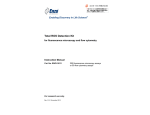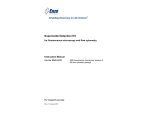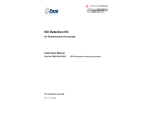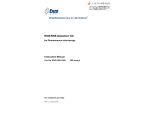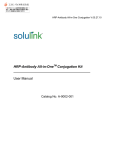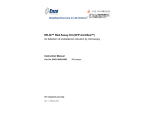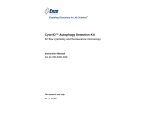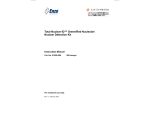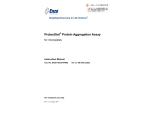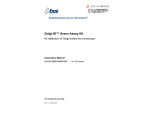Download User Manual-ENZ-51010 - Rev 3.1 Feb 2012.pub
Transcript
※本プロトコールは参考用の資料になり ます。商品ご購入の際は必ず商品に添付 されている資料をご参照ください。 Enabling Discovery in Life Science® Total ROS/Superoxide Detection Kit for fluorescence microscopy, flow cytometry and microplate assay Instruction Manual Cat. No. ENZ-51010 For research use only. Rev. 3.1 February 2012 200 fluorescence microscopy assays or 50 flow cytometry assays or 2 x 96-well plates Notice to Purchaser The Total ROS/Superoxide Detection Kit is a member of the CELLestial® product line, reagents and assay kits comprising fluorescent molecular probes that have been extensively benchmarked for live cell analysis applications. CELLestial® reagents and kits are optimal for use in demanding cell analysis applications involving confocal microscopy, flow cytometry, microplate readers and HCS/HTS, where consistency and reproducibility are required. This product is manufactured and sold by ENZO LIFE SCIENCES, INC. for research use only by the end-user in the research market and is not intended for diagnostic or therapeutic use. Purchase does not include any right or license to use, develop or otherwise exploit this product commercially. Any commercial use, development or exploitation of this product or development using this product without the express prior written authorization of ENZO LIFE SCIENCES, INC. is strictly prohibited. Limited Warranty This product is offered under a limited warranty. The product is guaranteed to meet appropriate specifications described in the package insert at the time of shipment. Enzo Life Sciences’ sole obligation is to replace the product to the extent of the purchase price. All claims must be made to Enzo Life Sciences, Inc. within five (5) days of receipt of order. Trademarks and Patents Enzo and CELLestial are trademarks of Enzo Life Sciences, Inc. Several of Enzo’s products and product applications are covered by US and foreign patents and patents pending. Contents I. Introduction ............................................................... 1 II. Reagents Provided and Storage.............................. 2 III. Additional Materials Required ................................. 2 IV. Safety Warnings and Precautions........................... 3 V. Methods and Procedures ......................................... 3 A. REAGENT PREPARATIONS ............................................................. 3 B. CELL PREPARATIONS .................................................................... 5 C. FLUORESCENCE/CONFOCAL MICROSCOPY (ADHERENT CELLS) ...... 5 D. FLUORESCENCE/CONFOCAL MICROSCOPY (SUSPENSION CELLS) ... 6 E. FLOW CYTOMETRY (ADHERENT CELLS) ......................................... 7 F. FLOW CYTOMETRY (SUSPENSIONCELLS) ....................................... 8 G. FLUORESCENCE MICROPLATE ASSAY (ADHERENT CELLS) .............. 9 H. FLUORESCENCE MICROPLATE ASSAY (SUSPENSIONCELLS) .......... 10 VI. Appendices ............................................................. 12 A. FILTER SET SELECTION............................................................... 12 B. SETTING UP OPTIMAL EXPOSURE TIME FOR DETECTION OF THE DYES .............................................................................. 12 C. COMPENSATION CORRECTION FOR FLOW CYTOMETRY................. 12 D. ANTICIPATED RESULTS (FLUORESCENCE MICROSCOPY) ............... 13 E. FLOW CYTOMETRY DATA ANALYSIS AND ANTICIPATED RESULTS .. 14 F. FLUORESCENCE MICROPLATE ASSAY DATA ANALYSIS AND ANTICIPATED RESULTS ........................................................ 15 VII. References .............................................................. 16 VIII. Troubleshooting Guide ......................................... 17 I. Introduction Free radicals and other reactive species play influential roles in many human physiological and pathophysiological processes, including cell signaling, aging, cancer, atherosclerosis, macular degeneration, sepsis, various neurodegenerative diseases (Alzheimer’s and Parkinson’s disease) and diabetes. Once produced within a cell, free radicals can damage a wide variety of cellular constituents, including proteins, lipids and DNA. However, at lower concentrations these very same agents may serve as second messengers in cellular signaling. Information-rich methods are required to quantify the relative levels of various reactive species in living cells and tissues, due to the seminal role they play in physiology and pathophysiology. The Total ROS/Superoxide Detection Kit enables detection of comparative levels of total ROS/RNS and also allows determination of superoxide production in live cells. Through the combination of two specific fluorescent probes, the kit provides a simple and specific assay for the real-time measurement of global levels of reactive oxygen species (ROS), peroxynitrite and specifically superoxide in living cells. This kit is designed to directly monitor real time reactive oxygen and/or nitrogen species (ROS/RNS) production in live cells using fluorescence microscopy and/or flow cytometry. The kit includes two fluorescent dye reagents as major components: Oxidative Stress Detection Reagent (Green) for ROS detection and Superoxide Detection Reagent (Orange). The non-fluorescent, cell-permeable ROS detection dye (green probe) reacts directly with a wide range of reactive species, such as hydrogen peroxide (H2O2), peroxynitrite (ONOO⎯), hydroxyl radicals (HOy), nitric oxide (NO), and peroxy radical (ROOy), yielding a green fluorescent product indicative of cellular production of different ROS/RNS types. However, the green probe has a low sensitivity for superoxide (O2y⎯), as well as Hypochlorous acid (HClO) and nitric oxide (NO), relative to other free radicals. The superoxide detection dye (orange probe) is a cellpermeable probe that reacts specifically with superoxide (O2y⎯), generating an orange fluorescent product. The kit is not designed to detect reactive chlorine or bromine species, as the fluorescent probes included are relatively insensitive to these analytes. Upon staining, the fluorescent products generated by the two dyes can be visualized using a wide-field fluorescence microscope equipped with standard green (490/525 nm) and orange (550/620 nm) filter set, or cytometrically using any flow cytometer equipped with a blue (488 nm) laser. 1 II. Reagents Provided and Storage All reagents are shipped on dry ice. Upon receipt, the kit should be stored at -20°C, or -80°C for long term storage. When stored properly, these reagents are stable for at least twelve months. Avoid repeated freezing and thawing. Reagents provided in the kit are sufficient for at least 200 microscopy assays or 50 flow cytometry assays using live cells (adherent or in suspension. Reagent Quantity Oxidative Stress Detection Reagent (Green) 300 nmoles Superoxide Detection Reagent (Orange) 300 nmoles ROS Inducer (Pyocyanin) 1 µmole ROS Inhibitor (N-acetyl-L-cysteine) 2 x 10 mg Wash Buffer Salts 1 pack III. Additional Materials Required • CO2 incubator (37°C) • Standard fluorescence microscope or flow cytometer equipped with a blue laser (488 nm) • Calibrated, adjustable precision pipetters, preferably with disposable plastic tips • 5 mL round bottom polystyrene tubes for holding cells during induction of ROS/RNS (for suspension cells only) and during staining and assay procedure • Adjustable speed centrifuge with swinging buckets • Glass microscope slides • Glass cover slips • Deionized water • Anhydrous DMF (100%) 2 IV. Safety Warnings and Precautions • This product is for research use only and is not intended for diagnostic purposes. • Reagents should be treated as possible mutagens and should be handled with care and disposed of properly. • Observe good laboratory practices. Gloves, lab coat, and protective eyewear should always be worn. Never pipet by mouth. Do not eat, drink or smoke in the laboratory areas. All blood components and biological materials should be treated as potentially hazardous and handled as such. They should be disposed of in accordance with established safety procedures. • To avoid photobleaching, perform all manipulations in low light environments or protected from light by other means. V. Methods and Procedures NOTE: Allow all reagents to warm to room temperature before starting with the procedures. Upon thawing of solutions, gently hand-mix or vortex thereagents prior to use to ensure a homogenous solution. Briefly centrifuge the vials at the time of first use, as well as for all subsequent uses, to gather the contents at the bottom of the tube. A. REAGENT PREPARATIONS Reconstitution or dilution of any and all reagents in DMSO should be avoided, as this solvent inhibits hydroxyl radical generation in cells. 1. Detection Reagents 1.1 The Oxidative Stress Detection Reagent (Green) is supplied lyophilized and should be reconstituted in 60 μL anhydrous DMF to yield a 5 mM stock solution. Upon reconstitution, the stock solution should be stored at -20°C. Gently mix before use. 1.2 The Superoxide Detection Reagent (Orange) is supplied lyophilized and should be reconstituted in 60 μL anhydrous DMF to yield a 5 mM stock solution concentration. Upon reconstitution, the stock solution should be stored at -20°C. Gently mix before use. 3 2. Positive Control The ROS Inducer (Pyocyanin) is supplied lyophilized and should be reconstituted in 100 µL anhydrous DMF to yield a 10 mM stock solution. For use, a final concentration of 200-500 μM is recommended. However, the optimal final concentration is celldependent and should be determined experimentally for each cell line being tested. ROS induction generally occurs within 20-30 minutes upon pyocyanin treatment and may decrease or disappear after that time. Plan accordingly. 3. Negative Control The ROS Inhibitor (N-acetyl-L-cysteine) should be reconstituted in 123 μL of deionized water to yield a 0.5 M stock solution. N-acetyl-cysteine is not readily soluble and may require vortexing. For use, a final concentration of 5 mM is recommended. However, the optimal final concentration is cell-dependent and should be determined experimentally for each cell line being tested. Endogenous fluorescence of untreated cells should be determined in advance or per assay. 4. 1X Wash Buffer Prepare 1X Wash Buffer by dissolving the contents of the pack in 1 liter of deionized water. When not in use, the 1X Wash Buffer should be stored refrigerated. Warm to room temperature before use. 5. ROS/Superoxide Detection Mix Prepare the ROS/Superoxide Detection Mix as follows: To every 10 mL of 1X Wash Buffer (see step 4) or culture medium, add 2 µL Oxidative Stress Detection Reagent (Green) and 2 µL Superoxide Detection Reagent (Orange). Gently mix. To prepare smaller volumes of ROS/Superoxide Detection Mix, intermediate1:10 dilution of both Green and Orange detection reagents in 1X Wash Buffer or culture medium is recommended. NOTE: To perform the compensation correction, single stained samples should be used. Make sure single component solutions (Green and Orange) are available. NOTE: Depending on the experiments, dyes can be used separately according to a provided protocol. 4 B. CELL PREPARATIONS Cells should be maintained via standard tissue culture practices. Always make sure that cells are healthy and in the log phase of growth before using them for the experiment. C. FLUORESCENCE/CONFOCAL MICROSCOPY (ADHERENT CELLS) 1. The day before the experiment, seed the cells directly onto glass slides or polystyrene tissue culture plates to ensure ~50-70% confluency on the day of the experiment. IMPORTANT: Cells should be healthy and not overcrowded since results of the experiments will depend significantly on the cells’ condition. 2. Load the cells with the ROS/Superoxide Detection Mix (see step A-5, page 4) using a volume sufficient to cover the cell monolayer and incubate under normal tissue culture conditions for 1 hour. 3. Carefully remove the ROS/Superoxide Detection Mix from the glass slides by gently tapping them against layers of paper towel, or from tissue culture plates. Optional: Cells may be washed with the 1X Wash Buffer. 4. Treat the cells with an experimental test agent. Separate positive control samples should be treated with the ROS Inducer (Pyocyanin). Negative Control samples should be established by treatment with the ROS Inhibitor (N-acetyl-L-cysteine). NOTE: Cells should be treated with the ROS Inhibitor 30 minutes prior to induction. All treatments should be performed under normal tissue culture conditions. It is recommended to perform a pretreatment by adding the ROS Inhibitor to the aliquots of ROS/Superoxide Detection Mix for the last 30 minutes of the reagent loading. Treatment with an experimental test agent or ROS inducer included with the kit should be performed in the cell culture media without dye. 5. Carefully wash cells twice with 1X Wash Buffer in a volume sufficient to cover the cell monolayer. 6. Immediately overlay the cells with a cover slip and observe them under a fluorescence/confocal microscope using standard excitation/emission filter sets. Make sure prepared samples are protected from drying. Dried out cells may present different fluorescence patterns. 5 Recommended filter sets: • Oxidative stress detection requires a filter set compatible with Fluorescein (Ex/Em: 490/525nm). • Superoxide detection requires a filter set compatible with Rhodamine (Ex/Em: 550/620nm). NOTE: Different exposure times may be required for optimal detection of the two dyes used in the kit. D. FLUORESCENCE/CONFOCAL MICROSCOPY (SUSPENSION CELLS) 1. Cells should be cultured to a density not to exceed 1 x 106 cells/ mL. Make sure that cells are in the log phase of growth before starting an experiment. IMPORTANT: Cells should be healthy and not overcrowded since results of the experiments will depend significantly on the cells’ overall condition. A sufficient volume of cells should be centrifuged at 400 x g for 5 minutes, yielding a working cell count of 1 x 105 cells/sample. 2. Resuspend the cell pellet in 200 μL of ROS/Superoxide Detection Mix (see step A-5, page 5) and incubate under normal tissue culture conditions for 1 hour with periodic shaking. 3. Centrifuge the cells at 400 x g for 5 minutes to remove the ROS/ Superoxide Detection Mix. Optional: Resuspend the cells in 5 mL 1X Wash Buffer, centrifuge them at 400 x g for 5 minutes and remove the supernatant. 4. Treat the cells with an experimental test agent. Separate positive control samples should be treated with the ROS Inducer (Pyocyanin). Negative Control samples should be established by treatment with the ROS Inhibitor (N-acetyl-L-cysteine). NOTE: Cells should be treated with the ROS Inhibitor 30 minutes prior to induction. All treatments should be performed under normal tissue culture conditions. It is recommended to perform a pretreatment by adding the ROS Inhibitor to the aliquots of ROS/Superoxide Detection Mix for the last 30 minutes of the reagent loading. Treatment with an experimental test agent or ROS inducer included with the kit should be performed in the cell culture media without dye. 5. Centrifuge the cells at 400 x g for 5 minutes. 6 6. Resuspend the cells in 5 mL of 1X Wash Buffer, centrifuge them at 400 x g for 5 minutes and remove the supernatant. 7. Resuspend the cells in 100 μL of 1X Wash Buffer and apply a 20 μL aliquot of the cell suspension, sufficient for 2 x 104 cells, onto a microscope slide. Immediately overlay the cells with a cover slip and analyze immediately via fluorescence microscopy. Make sure that prepared samples are protected from drying. Dried out cells may present different fluorescence patterns. Recommended filter sets: • Oxidative stress detection requires a filter set compatible with Fluorescein (Ex/Em: 490/525nm). • Superoxide detection requires a filter set compatible with Rhodamine (Ex/Em: 550/620nm). NOTE: Different exposure times may be required for optimal detection of the two dyes used in the kit. E. FLOW CYTOMETRY (ADHERENT CELLS) 1. The day before the experiment, seed the cells on appropriate tissue culture plates to ensure ~ 50-70% confluency on the day of the experiment. IMPORTANT: Cells should be healthy and not overcrowded since results of the experiments will depend significantly on the cells’ condition. 2. Induce the cells with an experimental test agent. Separate positive control sample should be treated with the ROS Inducer (Pyocyanin). Negative Control samples should be established by treatment with the ROS Inhibitor (N-acetyl-L-cysteine) NOTE: Cells should be pre-treated with the ROS Inhibitor at least 30 minutes prior to induction. All treatments should be performed under normal tissue culture conditions. 3. Remove the media with the inducers/inhibitors from the cells by aspiration. Carefully wash cells twice with 1X Wash Buffer in a volume sufficient to cover the cell monolayer, aspirate the supernatant. 4. Detach cells from the tissue culture plates using any appropriate method, collect cells in 5 mL round-bottom polystyrene tubes and wash them with 1X Wash Buffer. Centrifuge the cell suspension for 5 min. at 400 x g at room temperature. Discard the supernatant. 7 5. Resuspend the cell pellet in 500 µL of ROS/Superoxide Detection Mix (see step A-5, page 5). Stain cells for 30 min. at 37°C in the dark. No washing is required prior to the analysis of the samples by flow cytometry. IMPORTANT: Compensation correction will be needed to avoid overlap between green and orange fluorescent signals (see Appendix C). Recommended controls for compensation correction: • Unstained untreated cells • Positive control cells (pyocyanin-treated) stained with Oxidative Stress Detection Reagent (Green) only (“Green” cells) • Positive control cells (pyocyanin-treated) stained with Superoxide Detection Reagent (Orange) only (”Orange” cells) F. FLOW CYTOMETRY (SUSPENSION CELLS) 1. Cells should be cultured to a density not to exceed 1 x 106 cells/ mL. Make sure that cells are in the log phase of growth before starting an experiment. IMPORTANT: Cells should be healthy and not overcrowded since results of the experiments will depend significantly on the cells’ overall condition. A sufficient volume of cells should be centrifuged at 400 x g for 5 minutes, yielding a working cell count of 1-5 x 105 cells/ sample. 2. Induce the cells with an experimental test agent. A separate positive control sample should be treated with the ROS Inducer (Pyocyanin). A negative control sample should be established by treatment with the ROS Inhibitor (N-acetyl-L-cysteine). NOTE: Cells should be pre-treated with the ROS Inhibitor 30 minutes prior to induction. All treatments should be performed under normal tissue culture conditions. 3. Centrifuge the cells at 400 x g for 5 minutes. Discard supernatatant. 4. Resuspend the cells in 5 mL of 1X Wash Buffer, centrifuge them at 400 x g for 5 minutes and remove the supernatant. 5. Resuspend the cells in 500 μL of the ROS/Superoxide Detection Mix (see step A-5, page 5) and incubate 30 min at 37°C in the dark. No washing is required prior to the flow cytometry analysis. IMPORTANT: Compensation correction should be performed to avoid overlap between the green and orange fluorescent signals. 8 Recommended controls for flow cytometry: • Unstained untreated cells • Positive control cells (pyocyanin-treated) stained with Oxidative Stress Detection Reagent (Green) only (“Green” cells) • Positive control cells (pyocyanin-treated) stained with Superoxide Detection Reagent (Orange) only (”Orange” cells) G. FLUORESCENCE MICROPLATE ASSAY (ADHERENT CELLS) 1. The day before the experiment, seed the cells in 96-well black wall/clear bottom plates at a density of 1 – 2 x104 cells per well to ensure ~ 70-80% confluency on the day of the experiment. Leave several wells empty for the background fluorescence control measurements. IMPORTANT: Cells should be healthy and not overcrowded since results of the experiments will depend significantly on the cells’ condition. 2. Treat the cells (for highest quality data use at least 6 – 8 replicates for each condition tested) with the desired inducers. It is highly recommended that doses and time of treatment are established first. Establish positive controls (at least 6 – 8 replicates) by treatment of the cells with pyocyanin (see step A-2, page 4) for 30 min, at 37°C. Leave cells untreated or treated with vehicle only for the negative control (at least 6 – 8 replicates) (see step A-3, page 4). IMPORTANT: The dose of reagent and time of treatment are celldependent and should be determined experimentally for each cell line being tested (preliminary experimentation). 3. (Optional) An additional set of plates may be pretreated with the inhibitor (NAC) (see step A3, page 4), for 1 hour, at 37°C. Then treat NAC-inhibited cells with the desired inducer and with pyocyanin (see step A-2, page 4), for 30 min, at 37°C (for positive control). Leave a set of cells untreated as a negative control. Refer to step 2 above. 4. After treatment, remove the media containing the inducers. Optionally, the plates may be washed with 1X Wash Buffer using 200 µL per well (see step A4, page 4). 5. Add 100 µL/well of ROS/Superoxide Detection Mix (see step A5, page 4), and incubate for 60 min at 37°C. 9 6. Read the plates (bottom reading), without removing the detection mix, using a fluorescence microplate reader and standard fluorescein (Ex=488nm, Em=520nm) and rhodamine (Ex=550nm, Em=610nm) filter sets. 7. If required, Z’ factor may be calculated for each detection profile using the following formula:(5) Z’ = 1 – [(3*SDsample+3*SDcontrol)/(|Meansample – Meancontrol|)] H. FLUORESCENCE MICROPLATE ASSAY (SUSPENSION CELLS) NOTE: Perform all steps requiring centrifugation at 400 x g for 5 minutes using a centrifuge with swinging buckets. 1. Collect the cells by centrifugation at 400 x g for 5 min, re-suspend them in the appropriate cell culture medium at a density of 0.5 x 106 - 1.0 x 106 cells/mL, count and aliquot 100 µL of the suspension into wells of 96-well black wall plates. Leave several wells empty for the background fluorescence control measurements. IMPORTANT: Cells should be healthy and not overcrowded since results of the experiments will depend significantly on the cells’ condition. 2. Remove the medium by centrifugation of the plate and re-suspend the cells in 100 µL fresh medium containing the desired inducer(s). For highest quality data use at least 6 – 8 replicates for each condition tested. It is highly recommended that doses and time of treatment are established first. Establish positive controls (at least 6 – 8 replicates) by treatment of the cells with pyocyanin (see step A-2, page 4) for 30 min, at 37°C. Leave cells untreated or treated with vehicle only for the negative control (at least 6 – 8 replicates). See step A-3 on page 4. IMPORTANT: The dose of reagent and time of treatment are celldependent and should be determined experimentally for each cell line being tested (preliminary experimentation). 3. After treatment, remove the media containing the inducers by centrifugation of the plate. Discard the supernatant. Optionally, the plates may be washed with 1X Wash Buffer (see step A4, page 4) using 200 µL per well. Discard the supernatant by centrifugation. 10 4. (Optional) An additional set of plates may be pretreated with the inhibitor (NAC) (see step A3, page 4), for 1 hour at 37°C. After incubation, remove the medium containing the inhibitor by centrifugation of the plate. Discard the supernatant. Then re-suspend the NAC-inhibited cells in 100 µL medium containing the desired inducer(s) and pyocyanin (for positive control, see step A-2, page 4), for 30 min at 37°C. Leave a set of un-induced NAC-treated cells as a negative control. Refer to step H-2 on page 10. 5. After treatment, remove the media containing the inducers by centrifugation of the plate. Discard the supernatant. Optionally, the plates may be washed with 1X Wash Buffer (see step A4, page 4) using 200 µL per well. Discard the supernatant by centrifugation. 6. Re-suspend the cells with 100 µL/well of ROS/Superoxide Detection Mix (see step A5, page 4), and incubate for 60 min, at 37°C. 7. Read the plates, without removing the detection mix, using a fluorescence microplate reader and standard fluorescein (Ex=488nm, Em=520nm) and rhodamine (Ex=550nm, Em=610nm) filter sets. 8. If required, Z’ factor may be calculated for each detection profile using the following formula:(5) Z’ = 1 – [(3*SDsample+3*SDcontrol)/(|Meansample – Meancontrol|)] 11 VI. Appendices A. FILTER SET SELECTION For fluorescence microscopy, careful consideration must be paid to the selection of filters. Dichroic filters should be selected in which the “cut-off” frequency is optimally mid-way between the two emission bands that are desired (one reflected, the other transmitted). However, it is important to realize that dichroic filters have a somewhat limited reflectance range, i.e., a 600 nm short-pass dichroic filter may actually reflect light <500 nm. When selecting filters, it is critical to discuss with the filter or microscope manufacturer exactly what wavelength specifications are required for both the transmitted and the reflected light. In addition, filters should be obtained that have the highest possible transmission efficiency (typically requiring anti-reflection coating). Each optic that an emission beam must traverse will remove some fraction of the desired light. The difference between 80% transmission and 95% transmission for each detector may result in a greater than three-fold difference in the amount of light available to the detector. B. SETTING UP OPTIMAL EXPOSURE TIME FOR DETECTION OF THE DYES Optimal exposure times should be established experimentally for each dye used in the experiment. Both negative and positive controls should be utilized. Start with the negative control (untreated stained cells) and set up the exposure time so the fluorescent background is negligible. Then switch to a positive control (pyocyanin-treated cells) and adjust the exposure time to record a bright fluorescent image. Avoid saturation of the signal (very bright spots on the image). If saturation of the signal occurs, decrease the exposure time. It is recommended to acquire 5-6 single color images for each dye for each sample. C. COMPENSATION CORRECTION FOR FLOW CYTOMETRY Signals produced by peroxides, peroxynitrite and hydroxyl radicals will be detected in the FL1 channel. Superoxide production will be detected in the FL2 channel. To avoid overlap between green and orange fluorescent signals the following compensation procedure should be performed. 1. Run the unstained uninduced sample first. Generate a FSC versus SSC dot plot and gate out cell debris. 12 2. Generate a log FL1 (X-axis) versus a log FL2 (Y-axis) dot plot. Adjust PMT voltages for both channels so the signals from unstained cells should fall within the first log decade scale of FL1 and FL2 axes. 3. Run single stained “Green” positive control and adjust FL2-%FL1 compensation until the orange fluorescence signal will fall into the first decade of the log FL2 scale. 4. Repeat compensation procedure with the “Orange” single stained positive control and adjust FL1-%FL2 compensation until the green fluorescence signal will fall into the first decade of the log FL1 scale. NOTE: It is important to use the brightest positive single stained samples for proper compensation correction that allows distinguishing between negative and slightly positive (dim) cells. D. ANTICIPATED RESULTS (FLUOESCENCE MICROSCOPY) 1. The Superoxide Detection Reagent (Orange) yields an evenly distributed, bright orange nuclear staining pattern in induced cells. Note the structural change in positively treated cells versus control untreated cells (diffuse, dim cytoplasmic structural pattern observed in the control cells is replaced with uniform cytoplasmic staining and bright nuclear staining in superoxide-positive cells). 2. Increased levels of oxidative stress give a uniform green cytoplasmic staining in the presence of the Oxidative Stress Detection Reagent (Green). 3. ROS positive control samples, induced with ROS Inducer (Pyocyanin), exhibit a bright orange fluorescence in the nucleus as well as a bright green fluorescence in the cytoplasm. 4. Cells pretreated with the ROS Inhibitor (N-acetyl-L-cysteine) should not demonstrate any green or orange fluorescence upon induction. 5. Untreated samples should present only low autofluorescent background signal in any channel. 13 E. FLOW CYTOMETRY DATA ANALYSIS AND ANTICIPATED RESULTS 1. It is critical that positive (pyocyanin-induced) and control (untreated) samples be included in every experiment for every cell type. Negative (NAC-pretreated) sample is optional but very helpful. In preliminary experiments, it is important to establish appropriate doses of inducers and inhibitors for each cell type used. 2. Cell debris should be gated out using FSC versus SSC dot plot. 3. Generate a log FL1 (X-axis) versus a log FL2 (Y-axis) dot plot and add quadrants to it. Adjust quadrants so the majority of control cells (80-90%) will fall into lower left quadrant. Keep the same quadrant gate throughout the assay. NOTE: Remember that different cell types demonstrate different redox profiles therefore the number of the cells in the lower left quadrant may vary significantly between the cell lines. 4. Cells with increased production of superoxide demonstrate bright orange fluorescence and will be detected using the FL2 channel. Such cells will appear in the two upper quadrants of a log FL1 (X-axis) versus a log FL2 (Y-axis) dot plot. 5. Cells with increased levels of oxidative stress demonstrate a bright green staining in the presence of the Oxidative Stress Detection Reagent and can be registered in FL1 channel. Such cells will appear in the upper and lower right quadrants of a log FL1 (X-axis) versus a log FL2 (Y-axis) dot plot. 6. ROS positive control samples, induced with ROS Inducer (Pyocyanin), exhibit both bright orange and green fluorescence and appear to be positive in FL1 and FL2 channels. The increase of the cell population in the upper left, upper right and lower right quadrants will be registered. 7. Cells pretreated with the ROS Inhibitor (N-acetyl-L-cysteine) should not demonstrate significant green or orange fluorescence upon induction. 8. Control (untreated) samples should present only low autofluorescent background signal in any channel thus falling into the lower left quadrant on an FL1 versus FL2 dot plot. 9. Results of the experiments can be presented as percentage of the cells with increased ROS production or as increase in the mean fluorescence of the induced samples versus control. 14 F. FLUORESCENCE MICROPLATE ASSAY DATA ANALYSIS AND ANTICIPATED RESULTS 1. It is critical that positive (pyocyanin-induced) and control (untreated) samples be included in every experiment for every cell type. Negative (NAC-pretreated) sample is optional, but very helpful. In preliminary experiments, it is important to establish appropriate doses of inducers and inhibitors for each cell type used. 2. Cells with increased production of superoxide demonstrate bright orange fluorescence in the presence of the Superoxide Detection Reagent and the signal will be detected using standard rhodamine filter settings. 3. Cells with increased levels of oxidative stress demonstrate a bright green staining in the presence of the Oxidative Stress Detection Reagent and the signal will be detected using standard fluorescein filter setting. 4. ROS positive control samples, induced with ROS Inducer (Pyocyanin), exhibit both bright orange and green fluorescence and can be detected in both green and orange channels. Cells pretreated with the ROS Inhibitor (N-acetyl-L-cysteine) should not demonstrate significant green or orange fluorescence upon induction. 5. Control (untreated) samples should present only low autofluorescence signal in both channels. NOTE: Remember that different cell types demonstrate different redox profiles. Therefore, the auto-fluorescence signal may vary significantly in both channels. 6. Results of the experiments should be normalized using the background readings from empty wells (see step H1) and can be presented as ratios of the mean fluorescence of the induced samples versus control for each channel. 15 A B C D Figure 1. Jurkat cells were induced with 100 μM pyocyanin (general ROS inducer, panel B), 200 μM antimycin A (superoxide inducer, panel C) or 1 μM of t-butylhydroperoxide (peroxide inducer, panel D), stained with two color ROS Detection Kit and analyzed using flow cytometry. Untreated cells (panel A) were used as a control. Cell debris were ungated and compensation was performed using single stained pyocyanin-treated samples. Red numbers reflect the percentage of the cells in each quadrant. VII. References 1. Tarpey, M. and Fridovich, I. Circ Res. 89 (2001), 224-236. 2. Batandier ,C., et al. J Cell Mol Med. 6 (2002), 175-187. 3. Gomes, A., et al. J Biochem Biophys Meth. 65 (2005), 45-80. 4. Wardman, P. Free Rad Biol Med. 43 (2007), 995-1022. 5. Zhang, J.H., et al. J Bio Screening 4 (1999). 16 VIII. Troubleshooting Guide Problem Potential Cause Suggestion Dead or stressed (overcrowded) cells Prepare fresh cell culture for the experiments. Make sure that the cells are in the log growth phase. Band pass filters are too narrow or not optimal for fluorescent probes (fluorescence microscopy) Multiple band pass filters sets provide less light than single band pass ones. Use correct filter for each fluorophore. Check Methods and Procedures section of this manual and Appendix A for recommendations. Insufficient fluorescent dye concentration Follow the procedures provided in this manual. Insufficient inducer concentration Determine an appropriate concentration of inducer for the cell line(s) used in the study. Species of interest may react with each other, thus attenuating the expected signal. Check signaling pathways and all the components present in the cellular environment. Make sure that time of detection is optimized and the samples are prepared immediately. Low or no fluorescent signal in positive control Inappropriate time point of the detection Orange signal may disappear over time because of subsequent reactions of superoxide with other species like NO. Green signal may quench if concentration of product becomes too high (due to long exposure to the inducer). Otherwise, oxidized product may eventually leak out of the cells when left for a prolonged period. Overcompensation of the signal (flow cytometry) Change the values of compensation correction using single stained positive samples. Follow recommendation in the Appendix. Cell density is too low in microplate well. Check the cell count to confirm proper cell density. For suspension cells, careful removal of supernatant after washing steps is critical, as cells may be dislodged and washed away. 17 Problem High fluorescent background Potential Cause Suggestion Stressed (overcrowded) cells Prepare new cell culture for the experiment. Make sure that the cells are in the log growth phase. Band pass filters are too narrow or not optimal for fluorescent probes. Use correct filter for each fluorophore. Check Methods and Procedures section of this manual and Appendix A for the recommendations. Minimal spectral overlap should occur with the selected set of filters. Wash step is necessary. Follow the procedures provided in this manual, making optional wash steps mandatory. Inappropriate time point for detection Make sure that time of detection is optimized and the samples are prepared immediately. Inappropriate cell conditions Make sure that you have viable cells at the beginning of the experiment, and that the inducer treatment does not kill the cells during the time frame of the experiment . Inappropriate inhibitor concentration (too low or too high) No decrease in the fluorescent signal after using a specific inhibitor Inappropriate time point for detection Very low doses of inhibitor may not affect ROS production by inducer. Alternatively, very high doses of the inhibitors may cause oxidative stress itself and generate fluorescent signal. Optimize the concentration of the inhibitor and pretreatment time for each particular cell line. When cells are kept too long with the inhibitors or at very high inducer concentrations, after a certain time, the inhibitor becomes insufficient. Make sure that time of detection is optimized. Use correct filter for each fluorophore. Check Methods and Procedures section of this manual Inappropriate filter set on the and Appendix A for the recommicroscope mendations. Minimal spectral overlap should occur with the selected set of filters. 18 www.enzolifesciences.com Enabling Discovery in Life Science® GLOBAL HEADQUARTERS Enzo Life Sciences Inc. 10 Executive Boulevard Farmingdale, NY 11735 Toll-Free: 1.800.942.0430 Phone: 631.694.7070 Fax: 631.694.7501 [email protected] EUROPE/ASIA Enzo Life Sciences (ELS) AG Industriestrasse 17 CH-4415 Lausen Switzerland Phone: +41/0 61 926 89 89 Fax: +41/0 61 926 89 79 [email protected] For local distributors and detailed product information visit us online: www.enzolifesciences.com
























